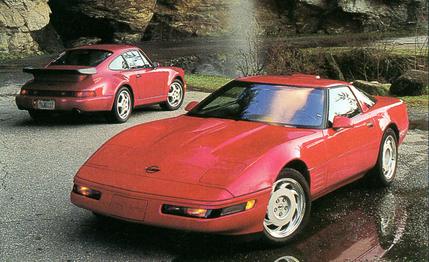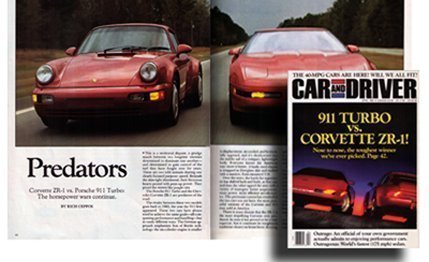 Comparison Tests
Comparison Tests
This is a territorial dispute, a grudge match between two longtime enemies determined to dominate one another — and determined to gain control of the turf they have fought over for years. These are two wild animals sharing one clearly focused purpose: speed. Beneath the skin-tight sheetmetal, their ferocious hearts pound with pent-up power. They prowl the streets like jungle cats.
The Porsche 911 Turbo and the Chevrolet Corvette ZR-1 are predators of the road.
The rivalry between these two models goes back to 1965, the year the 911 first appeared. These two cars have always tried to achieve the same goals — all-conquering performance and handling — but in vastly different ways. The German approach emphasizes Son of Beetle technology: the six-cylinder engine is smaller in displacement, air-cooled, and horizontally opposed, and it's shoehorned into the stubby tail of a compact, lightweight body. Everyone knows the American way: more is better. A husky steel chassis is wrapped in fiberglass skin and stuffed with a massive, front-mounted V-8.
Over the years, the battle for superiority has shifted back and forth, as first one and then the other upped the ante with a variety of strategies: better suspensions, more power, more efficient aerodynamics. This perennial contest has resulted in the two cars you see here, the most powerful versions of the Corvette and 911 ever sold in America.

There is scant dissent that the ZR-1 is the most stupefying Corvette ever produced. In tests it has proved to be a true supercar, but it continues its roughneck tradition — heavy on brute force, dizzying speed, and race-car handling but lacking in grace and refinement. It's still a wild thing, one of the wildest automobiles this side of a $400,000 Ferrari F40.
Going into this test, the new 911 Turbo posed a number of questions. Its predecessors, sold here off and on since 1978, have had a legendary history of alternately delighting and intimidating their drivers. Their chassis had an ornery streak, their powerful turbocharged engines suffered from hairy all-or-nothing response to the throttle, and their price tags were funnier than Rodney Dangerfield. And, of course, their fat-fendered bodies looked mean enough to make Corollas quake.
This new Porsche, however, is based on the thoroughly modernized Carrera 2 chassis. A perusal of its spec sheet indicates that it should be even hotter than before: its reworked 3.3-liter flat six is rated at 315 horsepower at 5750 rpm, up 33 hp from the last turbo. It boasts the fattest tires ever fitted to a 911 chassis. Its brake rotors are made from the same high-temperature alloy used on Porsche's 962 endurance racers. It packs an innovative limited-slip differential that not only improves driving traction, but can lock up under simultaneously braking and cornering to improve stability. But is this enough to make it the baddest cat in the asphalt jungle?
To find out, three C/D editors embarked on a three-day, 1300-mile, total-immersion experience. Hard driving had to be part of the trial, so we included a large dose of rural two-lane, and we dropped in at a race circuit to let these big cats really stretch out — the better to judge the capabilities of these nasty boys without worrying about sliding off into Uncle Fred's front yard.
There would be plenty of routine driving too: stop-and-go city traffic and long miles on Midwestern Interstates. After all, even a wild animal of the road is hemmed in by reality most of the time. Would either car be impossible to live with when the pace slowed down?

Our trek began on the Atlantic docks in Charleston, South Carolina, where the Porsche Turbo arrived from Germany.
From Charleston we headed down the coast to Savannah, Georgia, home of the Roebling Road race circuit. Roebling's combination of ample straightaways and daunting high-speed sweeps was tailor-made for powerful sports cars.
From there we scratched our way north on the kind of roads they write songs about: writhing two-lanes through North Carolina's Nantahala National Forest and the Great Smoky Mountains National Park (which North Carolina shares with Tennessee). We roared through enchanted forests and quiet valleys, past tin-roofed cabins with pungent smoke curling from their chimneys. The long final leg, Knoxville to Ann Arbor, was on mind-numbing Interstate.
But something else happens when you go on a long trip with cars of this nature. Cars like these can change your life, even if your affair with them is short. They confer power and authority and presence upon the driver. People respond differently around them. Things happen that feel extraordinary. You are stared at, examined, considered; the pedestrians wonder who you are. So, all the while, we were on another kind of uncharted trip, the route up in the head.
The effect is mildly narcotic, and it persuaded us to add a special category to the ratings chart that would reflect the mesmerizing effect these cars had on us and the people we came in contact with. We call it the "audacity rating."